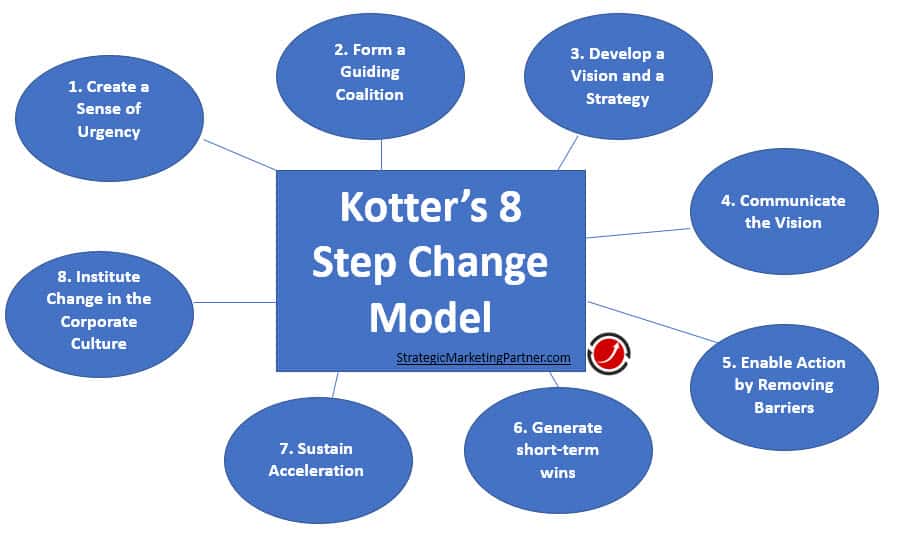Recency, frequency, monetary (RFM) | Marketing analysis
Recency, frequency, monetary (RFM) is one of the most powerful marketing strategies available. What does RFM mean in marketing?Also known […]
Read More »Become a successful marketing consultant: Learn more

As part of our strategic marketing and management series including SWOT analysis, Porter’s 5 Forces, Price’s Law, Pareto Principle and the Law of 80/20 and the Key Performance Indicators (KPIs) in Marketing, Kotter’s 8 Step model for change is a necessary strategic framework to have in your tool chest.
That’s because organizational change is crucial for any business that wants to thrive in an increasingly competitive and fast-paced business environment.
Yet, resistance to change is something all organizations grapple with.
Developed by John Kotter, a Harvard Business Professor, Kotter’s 8-step process for organizational change was developed by studying failed and successful change projects. These lessons are:
Most organizational change efforts fail—and, more often than not, they fail spectacularly.
But the organizations that successfully manage change do so in phases, whether they're restructuring, resizing, or tackling cultural change.
The Kotter 8-step change management model recognizes that adaptation is a necessity for sustainable business. It was first introduced to the world in 1995 in an article published in the Harvard Business Review titled “Leading Change: Why Transformation Efforts Fail.”
Some companies like Blockbuster Video and Kodak did not survive the change management process because they were ineffective at foreseeing and adapting to major changes.
The Kotter 8-step model focuses on effecting change from within in a way that brings all key stakeholders on board which allows for a more streamlined change process.
The Kotter model was developed in 1995, but is the process still relevant today?
Yes.
Kotter’s 8 Step Process is incredibly advantageous for organizations looking to implement long-lasting change because it focuses heavily on the individuals going through the change rather than solely focusing on the project itself. As a result, it leads to buy-in from an organization's employees, which greatly increases the chances of success.
The model also places emphasis on preparing for change. It offers an easy-to-understand roadmap that aims to fully embed change within an organization. It urges change managers to press ahead even after initial success to ensure that change becomes an integral part of organizational culture.
In essence, the Kotter Model is designed to help organizations create the right environment to effect change and develop the internal support they need to make the process successful and develop momentum so things don't stall.

Kotter’s change model is a top-down management change model that has 8 crucial steps. Here’s how to implement the steps within your organization.
If people aren’t motivated enough to change, the change management process will be met with resistance. While management may be driven by the bottom line, employees will find it challenging to move from their current way of doing things unless they truly understand the reason behind the change.
Not getting employees on board with the change process is one of the biggest reasons change stalls or fails. To create a sense of urgency:
Pushing major change onto your employees does nothing but guarantee pushback. To be successful, you must form coalitions with influential people within your organizations. This way, you're far more likely to drive through the change process successfully.
Getting the support of key personnel can help sustain that sense of urgency that's critical to change management. You can form powerful coalitions by:
Every successful transition requires a comprehensive vision of what the future state of the company will look like. Lack of a vision makes it hard to find support among stakeholders and will eventually stall the change process.
What you can do:
How you communicate your vision will determine if you achieve success. You'll need to share it frequently and powerfully. Use the vision to make decisions and solve problems. Connect the vision with crucial aspects of your organization, like performance reviews and training.
Are there any processes, structures, or hierarchies that are getting in the way of effective change? Removing barriers provides the freedom to work across silos and empowers people to execute your vision.
Nothing motivates more than success. It keeps the momentum going and makes the big goals seem more achievable. Think of the change process as more like a marathon than a sprint. Short-term wins are the people cheering on the sidelines who encourage runners to make it to the finish line.
Without these short-term wins, people will get tired of the process, become complacent and lose that all too important sense of urgency.
You’ll want to:
Organizations fail when they declare too soon. Just because you’re meeting all your performance metrics doesn’t mean the change is a shoo-in. Efforts to sustain change must go past the set “go-live” date to ensure all your progress doesn’t evaporate.
There’s always room for improvement, so:
The ultimate goal is to ensure change becomes an integral part of your organizational culture. Make the change visible and give it a solid place in your organization. You’ll also want to publicly recognize the individuals who were critical to the success of the process.
The Kotter 8-step change model is a people-focused structured approach that helps diffuse employee resistance to change. It requires an organization to identify and to communicate clearly why the transformation is necessary. Change processes are unlikely to succeed without buy-in from the employees.
To sustain the sense of urgency, it’s crucial to identify key leaders who have influence within the company. Gaining their support means you can build momentum, distill any fears, and effectively strategize and implement your vision.
Change does nothing by itself. You must take the initiative to ingrain the change into company culture for lasting impact.